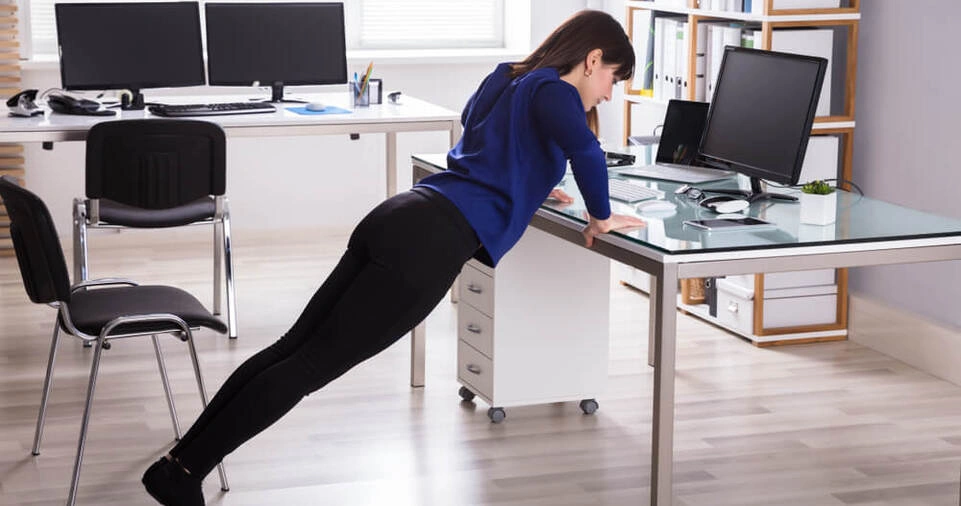Working from home has become a norm for many people across the globe, and while it brings flexibility and comfort, it can also lead to an unhealthy sedentary lifestyle.
Most individuals find themselves sitting for long hours, which can lead to a variety of health issues, including back pain, weight gain, and mental fatigue.
In the traditional office setup, there is natural movement — walking to meetings, going for a coffee break, and even just getting up to speak to a colleague.
But when working from home, the lines between work and personal life blur, and it becomes easier to fall into a routine of constant sitting, which negatively impacts overall well-being.
This comprehensive guide will provide actionable tips on how to stay active while working from home, helping you to improve your health, boost productivity, and maintain energy throughout the day.
From setting up an ergonomic workspace to incorporating regular movement and exercise, these strategies will empower you to stay healthy and active, even when you’re working remotely.
Why Staying Active is Crucial When Working From Home
The Sedentary Danger of Working from Home
When you work from home, it’s easy to slip into a sedentary lifestyle without even realizing it.
Without the usual commute or office movement, you may find yourself spending long hours sitting in front of your computer.
This constant sitting has been linked to several health problems, such as obesity, heart disease, and poor posture.
In fact, research has shown that prolonged sitting increases the risk of developing chronic diseases, including diabetes and cardiovascular issues.
Moreover, staying inactive while working can negatively affect your mental well-being.
Lack of physical activity can lead to anxiety, stress, and even depression, reducing your overall mood and productivity.
With limited movement, your muscles weaken, and your joints become stiff, leading to discomfort and pain, particularly in your back, shoulders, and neck.
The Importance of Movement for Mental and Physical Health
By incorporating regular physical activity into your daily routine, you can prevent the negative effects of sedentary behavior and improve both your physical and mental health.
Studies show that movement not only strengthens muscles and bones but also promotes better cognitive function, boosts energy levels, and enhances mood.
Active breaks during work can enhance concentration, creativity, and problem-solving skills, leading to higher productivity.
In addition to physical and cognitive benefits, regular movement helps reduce the strain caused by poor posture, which is a common issue for those who work from home.
Maintaining an active lifestyle will help you stay agile and avoid the common aches and pains associated with working in a stationary position.
Create a Dedicated Workspace

Why Having a Dedicated Workspace Matters
One of the key strategies for staying active while working from home is to create a dedicated workspace.
Many people are tempted to work from their couches or beds, but this setup often leads to poor posture and decreased productivity.
A dedicated workspace allows you to clearly define where work begins and ends, mentally separating your work life from your home life.
A well-designed workspace also encourages proper ergonomics, which can reduce strain on your body and improve your overall comfort.
Sitting at a desk or table with the correct chair height, proper screen positioning, and adequate lighting will minimize the likelihood of developing back, neck, or eye strain.
Tips for Setting Up an Active-Friendly Workspace
To create an active-friendly workspace, focus on the following:
- Ergonomics: Make sure your desk is at the proper height, with your elbows at a 90-degree angle. Your monitor should be at eye level to prevent straining your neck.
- Comfortable Seating: Invest in an ergonomic chair that supports your back and promotes good posture.
- Use a Standing Desk: Consider using a standing desk or adjustable desk converter, which allows you to alternate between sitting and standing throughout the day.
- Stretch-Friendly Space: Leave space in your workspace for quick stretches or light exercises, such as standing calf raises or seated leg extensions.
- Keep Tools Accessible: Store your water bottle, resistance bands, or small weights within reach to encourage use throughout the day.
By creating a workspace that encourages movement and supports ergonomic health, you can set the stage for a more active and productive workday.
ALSO READ: How to Automate Business Processes Using Custom Software
Take Short Breaks and Stretch Regularly
The Importance of Regular Breaks
Sitting for long periods without breaks can lead to stiffness, fatigue, and discomfort. It’s essential to take short breaks every 60 minutes to move your body and stretch.
Short, frequent breaks improve circulation and provide mental clarity, which can help you refocus and be more productive.
Studies suggest that taking a break every hour significantly boosts energy levels and mental sharpness.
These breaks don’t have to be long or complicated — even just standing up, stretching, or walking around for a few minutes can make a huge difference in how you feel throughout the day.
Types of Breaks You Can Take
Here are some effective break activities to incorporate into your workday:
- Standing Break: Simply standing up for a few minutes can help reduce muscle tension. Try walking around your home or doing light activities like making a cup of tea or organizing your desk.
- Stretching: Incorporate stretching exercises to release tension and increase flexibility. Focus on areas that are prone to stiffness, like the neck, shoulders, hips, and legs.
- Walking Break: Take a 5-10 minute walk around your home or go outside if possible. Walking boosts circulation and clears your mind.
Make these breaks a non-negotiable part of your workday. Set a timer or use apps that remind you to take breaks, ensuring you stay consistent with your movement throughout the day.
Desk Exercises to Stay Active

Simple Desk Exercises for a Healthier Workday
Even if you don’t have time for a full workout, you can still perform simple desk exercises that promote movement and prevent stiffness.
These exercises target key muscle groups, such as the legs, back, and arms, and can be done in just a few minutes.
Some easy desk exercises include:
- Seated Leg Raises: Sit upright in your chair and extend one leg straight out. Hold for a few seconds before lowering it. Alternate legs and repeat.
- Desk Push-Ups: Stand a few feet away from your desk and place your hands on it. Lower your chest towards the desk by bending your elbows, then push back up. This works your arms, shoulders, and chest.
- Shoulder Rolls: Sit up straight and roll your shoulders forward in a circular motion, then reverse the direction. This helps reduce tension in the neck and shoulders.
- Wrist and Finger Stretches: Stretch your wrists and fingers periodically to prevent strain from typing. Gently extend your arm out and flex your wrist backward, holding the stretch for a few seconds.
Incorporating these exercises into your daily routine will keep your muscles engaged and reduce the risk of developing stiffness or discomfort.
Use a Standing Desk or Desk Converter
Benefits of Standing Desks
One of the best ways to combat the negative effects of sitting is to use a standing desk or an adjustable desk converter.
Standing desks allow you to alternate between sitting and standing, which can improve posture, reduce back pain, and boost energy levels.
How to Set Up a Standing Desk
To set up a standing desk, follow these tips:
- Desk Height: Ensure that your standing desk is at the proper height. When standing, your elbows should form a 90-degree angle, and your screen should be at eye level.
- Comfortable Footwear: Wear comfortable shoes with cushioning to avoid putting pressure on your feet and joints.
- Anti-Fatigue Mat: Invest in an anti-fatigue mat to reduce the strain on your legs while standing for extended periods.
- Movement: Avoid standing in one place for too long. Alternate between sitting and standing every 30-60 minutes.
A standing desk is an excellent investment for people working from home who want to stay active and reduce the risks of prolonged sitting.
Exercise Before or After Work
Make Exercise a Daily Routine
Integrating exercise into your daily routine is one of the best ways to stay active while working from home.
You don’t need to spend hours at the gym — just a 20-30 minute workout before or after work can make a significant difference in your health.
Consider incorporating activities such as:
- Yoga: A gentle yoga practice helps improve flexibility, strength, and relaxation. It’s a great way to start or end your day.
- Bodyweight Exercises: Push-ups, squats, lunges, and planks are simple yet effective exercises that target multiple muscle groups.
- Cardio Workouts: Go for a jog, bike ride, or do a quick home workout like jumping jacks, high knees, or skipping rope to get your heart rate up.
ALSO READ: How to Build a Resilient Business in the Face of Economic Challenges
Conclusion
Working from home offers numerous benefits, but it also requires conscious effort to stay active and healthy.
By incorporating these strategies — from creating an ergonomic workspace to taking regular movement breaks — you can maintain an active lifestyle that will improve your physical health, boost productivity, and enhance your overall well-being.
Stay intentional about movement, and you’ll find that being active while working from home is both possible and rewarding.







